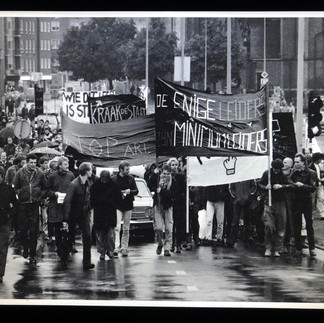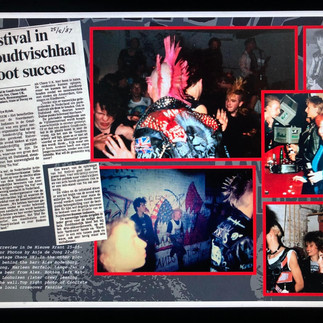Never Mind The Hype review Goudvishal
- david1170
- Jan 14, 2023
- 2 min read
NMTH editor Martijn Welzen delved into the story of the illustrious Arnhem stage the Goudvishal, recorded by Henk Wentink and Marcel Stol in the recently published English book 'Goudvishal: DIY or Die! / Punk in Arnhem 1977 – 1990'.
Where pop venues nowadays are really buildings where only music, in all possible variants, comes on stage, there was more behind it in the early days. The oldest stage places in the Netherlands, which sprang up at the end of the sixties, were often empty buildings on the edge of the city center that had, or just not, the label building collapse. Beginning musicians, and sometimes other artists, took up residence and did their thing under the radar of what was seen as culture within a municipality. All that took off much higher at the end of the 70s when punk, with the 'do-it-yourself' attitude attached to it, made its appearance.
In addition to music, it is also a socio-political movement that was already fighting against overconsumption and globalization. A place was needed for the unknown cultural and political excesses that the youth brought, and the municipalities demanded bureaucratic influence, for a permit or any subsidy. That's where the friction started.
Arnhem in Gelderland was no exception. Except maybe in appearance. As also mentioned on the back of the book, Arnhem was a significant player in the punk world. Even the statement 'biggest punk scene, after Amsterdam, of our little country' is suggested. From squat Stokvishal, to the other squat The Goudvishal, the book is a story about the struggle for individuality and self-determination. Organizing yourself with your group of friends, the construction of concerts, which nowadays is called production. Print the posters yourself, often as beautiful screen prints, sometimes as simple cut-and-paste work before Adobe even existed. And build a party with bands from around the corner or countries far away from us.
Also described are the protest actions for what the young punks saw as ideals worth fighting for, at a time when Apartheid still existed and nuclear weapons were placed in the Dutch polders. In addition, you feel that eternal battle with the environment for recognition. Punk was disdainfully hidden away, and if that did not help, the protests, regularly heavy-handed, were suppressed.
The book is therefore full of newspaper clippings that mainly deal with the unwillingness of a city council in the face of the intransigence of the punks. The period described runs from 1977 to 1990. However, the Goldfish Hall itself was only definitively closed in 2007, but the struggle became less in those years. The 13 years that the solid book does cover also have a nostalgic, almost romantic slant. Beautiful photos and time-bound flyers of concerts give the extra color that the Goudvishal has earned. Because it is a monument to underground culture, and not only in Arnhem.
The book 'Goudvishal: DIY or Die! / Punk in Arnhem 1977 – 1990' can be ordered via this link.




















Comments